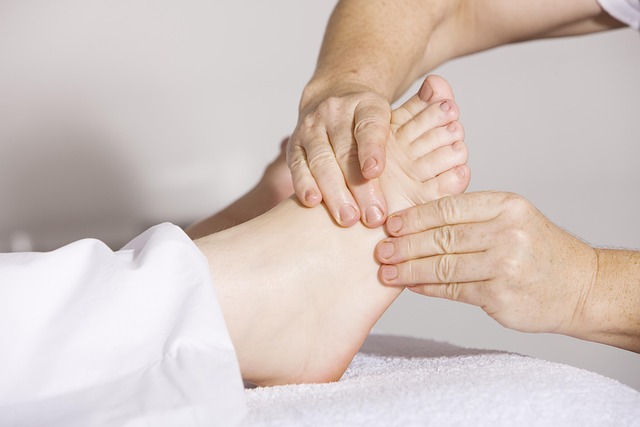PRP treatment for tendon injuries leverages a patient's own blood to accelerate healing through platelet-focused stimulation of collagen production, inflammation reduction, and angiogenesis, offering a non-surgical, natural alternative for athletes seeking faster recovery from sports-related tendon damage.
“Unleash your body’s healing potential with Platelet-Rich Plasma (PRP) therapy—a groundbreaking approach revolutionizing sports medicine. This innovative treatment has shown remarkable results in accelerating recovery from athletic injuries, particularly targeting tendon damage.
In this comprehensive guide, we explore PRP’s mechanism as a powerful tool to combat tendinopathy. By delving into the science and understanding its role, athletes and professionals alike can unlock faster recovery times and enhanced performance, making PRP treatment for tendon injuries a game-changer in sports rehabilitation.”
Understanding Platelet-Rich Plasma (PRP) Therapy
Platelet-Rich Plasma (PRP) therapy is a groundbreaking approach that leverages the body’s natural healing mechanisms to accelerate recovery from sports injuries, particularly those affecting tendons. PRP treatment involves extracting a patient’s own blood and separating it into its various components, with a focus on platelets—small cells known for their role in clotting but also rich in growth factors essential for tissue repair.
This concentrated solution of platelets and growth factors is then injected directly into the affected area, such as a damaged tendon. The growth factors stimulate fibroblasts to produce collagen, a crucial component for tendon healing and reinforcement. Additionally, PRP treatment reduces inflammation and promotes angiogenesis, enhancing blood flow to the injured site, which further facilitates the healing process. Studies have shown promising outcomes in using PRP treatment for tendon injuries, making it an attractive option for athletes seeking faster and more effective recovery without the need for invasive surgical procedures.
PRP's Role in Accelerating Sports Injury Recovery
Platelet-Rich Plasma (PRP) therapy has emerged as a powerful tool in accelerating sports injury recovery, particularly for tendon injuries. PRP treatment involves extracting a patient’s own blood and separating out the platelets, which are rich in growth factors and proteins that promote healing and tissue regeneration. These concentrated platelets are then injected back into the injured area, stimulating a robust healing response.
For athletes suffering from tendon tears or chronic tendinopathy, PRP offers a promising solution. The growth factors in PRP accelerate the repair process of damaged tendon fibers, fostering collagen production and strengthening the tendon. This not only reduces pain and inflammation but also improves overall tendon function, enabling athletes to return to their active lifestyles faster and with enhanced performance potential.
Targeted Treatment for Tendon Injuries
Tendon injuries are a common issue among athletes, often resulting in prolonged recovery times and reduced performance. Platelet-Rich Plasma (PRP) therapy offers a targeted treatment approach for such injuries, providing a natural and effective way to accelerate healing. PRP treatment involves harvesting blood from the patient, enriching it with a high concentration of platelets, and then injecting this concentrated plasma into the affected tendon.
Platelets play a crucial role in the body’s natural healing process by releasing growth factors that stimulate cell regeneration and collagen synthesis. This targeted mechanism makes PRP therapy particularly effective for tendon injuries, as it promotes tissue repair and reduces inflammation simultaneously. The non-invasive nature of PRP treatment, combined with its ability to harness the body’s inherent healing capabilities, makes it an attractive option for athletes seeking faster and more natural recovery from tendon-related sports injuries.
Science Behind PRP's Efficacy in Athletics
The science behind Platelet-Rich Plasma (PRP) therapy reveals a powerful tool in the athletic recovery arsenal. PRP treatment involves harnessing the body’s own healing mechanism by extracting a high concentration of platelets from a patient’s blood. These platelets are rich in growth factors, which play a pivotal role in tissue repair and regeneration. When injected into injured areas, such as tendons, PRP accelerates the healing process by stimulating cell proliferation and enhancing collagen synthesis.
Research has shown promising results for PRP treatment for tendon injuries, particularly in sports where overuse and repetitive stress are common. By promoting the body’s natural healing response, PRP can reduce inflammation, stimulate fibroblast activity, and improve tissue strength. This not only speeds up recovery but also potentially prevents chronic issues, making it a game-changer for athletes seeking efficient and effective solutions for tendon injuries.
Platelet-Rich Plasma (PRP) therapy is emerging as a game-changer in sports medicine, offering a targeted and effective approach to treating tendon injuries. By harnessing the body’s natural healing mechanisms, PRP treatment accelerates recovery, reducing recovery times and improving athletic performance. The science behind its efficacy continues to evolve, making PRP a promising solution for athletes seeking swift and lasting relief from sports-related injuries. For individuals suffering from tendon damage, PRP treatment could be the key to faster and more efficient healing, enabling them to get back in the game promptly.
